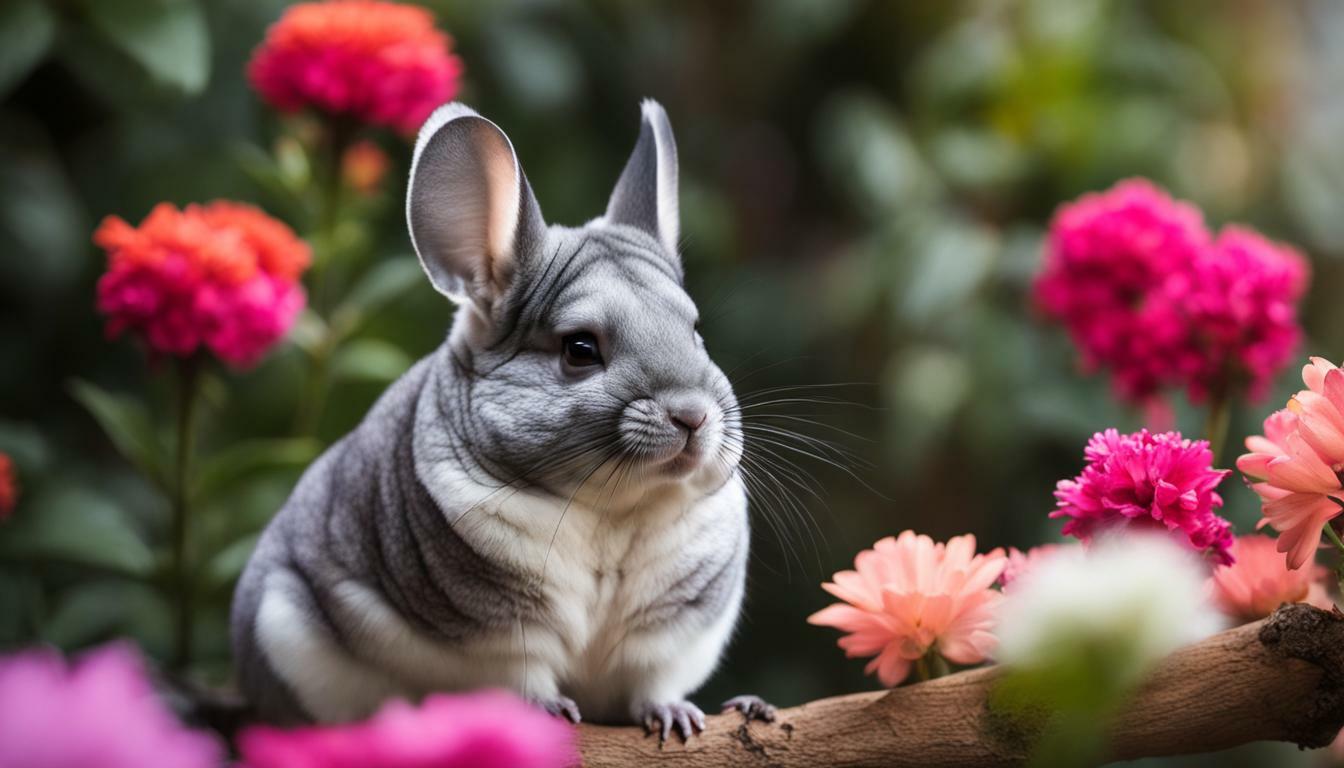If you’re wondering whether chinchillas can see color, you’re not alone. Many pet owners are curious about their furry friends’ visual abilities.
Chinchillas have reasonable vision, although it is not as good as humans. While they can see in color, it’s likely that they cannot perceive as many colors as humans can. Their vision is somewhat blurry, and they struggle to see fine details. Instead, chinchillas rely more on their hearing and smell to navigate their surroundings.
Chinchillas have a wide field of vision, allowing them to see a large area around them. However, their ability to see objects in the distance is limited. They have two types of cones in their eyes, which enable them to see shades of blue and green. Interestingly, chinchillas may have difficulty discerning different shades of blue, but they may have better vision for colors like yellows and greens.
When it comes to night vision, chinchillas excel. They have a surplus of rod cells in their eyes, which provide them with good night vision capabilities. This is particularly useful for their natural habitat, as they are nocturnal animals.
Despite these fascinating characteristics, there is still limited research on chinchilla color vision. More studies are needed to fully understand their ability to see colors and how it affects their behavior and wellbeing. Understanding chinchilla color vision can have implications for their care and environment, ensuring that pet owners create an optimal environment for their furry companions.
Key Takeaways
- Chinchillas can see in color, although not as many colors as humans.
- Their vision is blurry and lacks fine detail.
- Chinchillas rely more on their hearing and smell to navigate their surroundings.
- They have a wide field of vision but struggle to see objects in the distance.
- Chinchillas can see shades of blue and green, with potential difficulty discerning different shades of blue.
- They have excellent night vision thanks to an abundance of rod cells in their eyes.
- More research is needed to fully understand chinchilla color vision and its implications for their care and environment.
The Basics of Chinchilla Vision
Before we dive into the specifics of chinchillas’ color vision, let’s first understand how their overall visual abilities compare to humans. Chinchillas have reasonable vision, but it is not as sharp or detailed as ours. While they can see in color, their range of colors may not be as extensive as humans. Instead, they rely more on their hearing and sense of smell to navigate their surroundings.
Chinchillas have a wide field of vision, allowing them to see what’s happening around them. However, their ability to see in the distance is limited, and their vision becomes increasingly blurry as objects move further away. This lack of detail in their vision means that they may struggle to discern certain colors and rely more on contrast. For example, they may have more difficulty distinguishing shades of blue but have better vision for yellows and greens.
Interestingly, chinchillas have two types of cones in their eyes, which are responsible for color vision. They can perceive shades of blue and green, but their ability to see other colors is still not fully understood. Additionally, chinchillas have good night vision thanks to the abundance of rod cells in their eyes, allowing them to navigate and explore their environment even in low-light conditions.
Table: Chinchilla Vision Comparisons
| Visual Abilities | Chinchillas | Humans |
|---|---|---|
| Color Vision | Can see some colors, limited range | Can see a wide range of colors |
| Detail | Blurry vision, lack of detail | Sharp vision, high level of detail |
| Field of Vision | Wide field of vision | Narrower field of vision |
| Night Vision | Good night vision | Relies on artificial light |
While some research on chinchilla color vision has been conducted, there are still many unanswered questions. Further studies are needed to fully understand their ability to see colors and how it impacts their perception of the world. Understanding chinchilla color vision can have implications for their care and environment, such as providing appropriate color contrasts in their surroundings and considering their visual limitations when choosing toys or accessories for their habitats.
Can Chinchillas See in Color?
The good news is that chinchillas can indeed see in color, although not as vividly as humans. While their vision is not as sharp or detailed as ours, they still have the ability to perceive certain colors. Chinchillas have two types of cones in their eyes, which allow them to see shades of blue and green.
However, it’s important to note that chinchillas may have difficulty discerning certain shades of blue and may have better vision for yellows and greens. Their vision is also blurry, lacking the same level of detail that humans can perceive. This means that while they can see color, their visual acuity is not as high as ours.
Chinchillas rely more on their hearing and smell than their vision. Their wide field of vision allows them to have a good overall view of their surroundings, but their ability to see in the distance is limited. They have good night vision, thanks to the abundance of rod cells in their eyes.
Implications for Care and Environment
Understanding chinchilla color vision can have implications for their care and environment. For example, when designing their living space, it’s important to consider using colors that are more easily discernible for them, such as yellows and greens. Providing toys and accessories with contrasting colors can also enhance their visual stimulation.
| Key Takeaways: |
|---|
| Chinchillas can see in color, although not as vividly as humans. |
| They have two types of cones in their eyes, allowing them to perceive shades of blue and green. |
| Their vision is blurry and lacks detail, but they have a wide field of vision. |
| Understanding their color vision can help in creating an optimal environment for their well-being. |
Despite the progress made in understanding chinchilla color vision, there is still limited research on the subject. Further studies are needed to fully comprehend their ability to see colors and the implications it may have on their overall health and behavior. As pet owners, it’s important to continue supporting and encouraging research in this field to provide the best care possible for our chinchilla companions.
The Range of Colors Chinchillas Can See
Chinchillas have two types of cones in their eyes, allowing them to see a range of colors, particularly in the blue and green spectrum. While their color vision is not as extensive as that of humans, chinchillas can still perceive different shades and hues. This ability to perceive colors adds vibrancy to their world and enhances their overall visual experience.
Chinchillas may have difficulty discerning certain colors, such as shades of blue, due to their limited visual acuity and blurry vision. However, they tend to have better vision for colors in the yellow and green range. This is because their eyes are more sensitive to these colors, allowing them to differentiate between various shades within this spectrum.
It’s important to note that while chinchillas can see in color, their vision is not as sharp or detailed as that of humans. They rely more on their other senses, such as hearing and smell, to navigate their environment. Despite this, their wide field of vision, combined with their ability to perceive colors, contributes to their overall sensory experience and helps them adapt to their surroundings.
| Colors | Chinchilla Perception |
|---|---|
| Blue | May have difficulty discerning shades |
| Green | Can perceive shades within the green spectrum |
| Yellow | Good perception of yellows |
The Importance of Chinchilla Color Vision
Understanding the range of colors chinchillas can see is crucial for their care and environment. Providing them with visually stimulating surroundings that incorporate appropriate colors can enrich their lives and promote their overall well-being. This can include offering toys, bedding, and cage decorations that feature colors within their visual perception. By catering to their unique visual abilities, you can create a more engaging and comfortable environment for your pet chinchilla.
Chinchillas’ Blurry Vision and Lack of Detail
Unfortunately, chinchillas’ vision is quite blurry, and they are unable to see fine details like humans can. While they can see in color, their ability to discern specific details is limited. Chinchillas rely more on their other senses, such as hearing and smell, to navigate their surroundings. Their visual acuity is not as sharp as ours, but they make up for it with their wide field of vision.
Chinchillas have two types of cones in their eyes, which allow them to perceive shades of blue and green. However, they may struggle to distinguish between different shades of blue. On the other hand, they may have better vision when it comes to yellows and greens. It’s important to consider these color preferences when designing their environment, such as choosing toys and cage accessories that incorporate these colors.
Despite their blurry vision, chinchillas have excellent night vision. They have an abundance of rod cells in their eyes, which enables them to see well in low light conditions. This is an adaptation that helps them navigate their natural habitat and stay alert to potential predators. It’s fascinating to see how chinchillas have adapted their visual abilities to function optimally in their environment.
Although we have some understanding of chinchilla color vision, there is still limited research in this area. More studies are needed to fully comprehend their ability to perceive different colors and how it influences their behavior and well-being. Understanding chinchilla color vision can have practical implications for their care and environment. By creating an environment that takes into account their color preferences and visual limitations, we can provide them with a comfortable and enriching living space.
| Key Points: |
|---|
| Chinchillas’ vision is blurry and lacks detail. |
| They rely on their other senses, such as hearing and smell. |
| Chinchillas can perceive shades of blue and green, but may struggle with distinguishing shades of blue. |
| They have good night vision due to an abundance of rod cells in their eyes. |
| Further research is needed to fully understand chinchilla color vision and its implications for their care. |
Night Vision in Chinchillas
Chinchillas are relatively adept at seeing in the dark, thanks to their specialized night vision adaptation. Their eyes are equipped with a high number of rod cells, which are responsible for detecting light and motion in low-light conditions. This allows chinchillas to navigate their environment and find their way even when visibility is limited. While their night vision is not as sharp as during the day, it is still significantly better than that of humans.
Chinchillas rely on their night vision when they are most active, which is typically during the early morning or evening hours. This is when they come alive, displaying their natural behaviors such as exploring, playing, and foraging. Their ability to see in the dark is a valuable survival trait that helps them avoid predators and find food sources in their natural habitats.
It’s important to note that although chinchillas have good night vision, they still rely on their other senses such as hearing and smell to navigate their environment. Their keen sense of hearing allows them to pick up on sounds and detect approaching threats, while their acute sense of smell helps them identify food sources and communicate with other chinchillas.
Table: Comparison between Chinchilla Vision and Human Vision
| Aspect | Chinchilla Vision | Human Vision |
|---|---|---|
| Color Perception | Can see in color, but likely not as many colors as humans | Can see a wide range of colors |
| Visual Acuity | Blurry vision, lacks detail | Sharp and detailed vision |
| Field of Vision | Wide field of vision, but limited distance vision | Wide field of vision with good distance vision |
| Low-Light Vision | Good night vision due to an abundance of rod cells | Relatively poor night vision |
While chinchillas’ night vision is impressive, there is still limited research on their overall color vision. Further studies are needed to fully understand the range of colors they can perceive and any potential difficulties they may have in distinguishing certain hues. Understanding chinchilla color vision can have implications for their care and the design of their living environment. By creating an environment that takes into account their visual capabilities, chinchilla owners can ensure their pets’ well-being and optimize their overall quality of life.
Research Gaps and Implications
While some studies have shed light on chinchillas’ color vision, there is still much to learn about this fascinating topic. The current research indicates that chinchillas have reasonable vision, but it is not as good as humans. They can see in color, although likely not as many colors as humans can. Their vision is blurry and lacks detail, which means they rely more on their hearing and smell to navigate their environment.
Chinchillas have a wide field of vision, but their ability to see in the distance is limited. They have two types of cones in their eyes which allow them to see shades of blue and green. However, they may have difficulty discerning shades of blue and may have better vision for yellows and greens. This knowledge has implications for their care and environment. For example, it can help pet owners understand why certain colors may be more stimulating or soothing for their chinchillas.
Understanding the limitations and nuances of chinchilla color vision can also have implications for their overall well-being. For instance, it can inform the design of chinchilla habitats and enclosures, ensuring that the colors and materials used are suitable for their visual capabilities. Additionally, it can guide the selection of toys and accessories, taking into consideration their color preferences and ability to perceive different shades.
Despite the progress made in chinchilla color vision research, there is still a need for more comprehensive studies to fully understand their ability to see colors. Further research can delve into areas such as the range of colors chinchillas can perceive, their preferences for certain color combinations, and any potential impacts of color vision on their behavior and interactions. By filling these research gaps, we can enhance our understanding of these unique animals and provide better care for them.
| Key Points | Implications |
|---|---|
| Chinchillas have reasonable vision but it is not as good as humans. | Understanding their visual limitations can help tailor their environment to their needs. |
| They can see in color, although likely not as many colors as humans can. | Choosing appropriate colors in their habitat and accessories can enhance their well-being. |
| Their vision is blurry and lacks detail. | Relying more on their other senses, such as hearing and smell, for navigation. |
| Chinchillas have a wide field of vision, but their ability to see in the distance is limited. | Creating suitable enclosures that account for their visual range. |
| They have two types of cones in their eyes which allow them to see shades of blue and green. | Understanding their color preferences and potential difficulties in discerning certain shades. |
| Chinchillas have good night vision due to the abundance of rod cells in their eyes. | Ensuring their habitats provide appropriate lighting conditions during nighttime. |
| Further research is needed to fully understand their ability to see colors. | Continued studies can provide valuable insights for their care and well-being. |
Understanding Chinchilla Color Vision for Pet Owners
As a chinchilla owner, understanding your pet’s color vision can help you create a stimulating and comfortable living space for them. While chinchillas can see in color, their vision is not as sharp or detailed as ours. They rely more on their hearing and smell to navigate their environment. Nevertheless, understanding their visual capabilities can enhance their overall well-being.
Chinchillas have a wide field of vision, allowing them to have a good sense of their surroundings. However, their ability to see in the distance is limited. They have two types of cones in their eyes, which enable them to perceive shades of blue and green. While they may struggle to discern shades of blue, they might have better vision for colors like yellow and green.
It’s important to note that chinchillas’ vision is blurry and lacks detail. They can distinguish between colors, but their perception may not be as nuanced as ours. Additionally, chinchillas have excellent night vision due to the high number of rod cells in their eyes, which allows them to navigate their surroundings even in low light conditions.
Research on chinchilla color vision is still limited, and there is much more to learn about their visual capabilities. However, understanding their color vision can have implications for their care and environment. For example, you can incorporate colorful toys and accessories into their living space to provide visual stimulation. It’s also important to consider the color of their bedding or cage materials, as certain colors may be more visually appealing to them.
| Key Points to Remember |
|---|
| Chinchillas can see in color, but their vision is not as sharp or detailed as humans. |
| They rely more on their hearing and smell to navigate their environment. |
| Chinchillas have a wide field of vision, but their ability to see in the distance is limited. |
| They have two types of cones in their eyes, allowing them to see shades of blue and green. |
| Chinchillas may have difficulty discerning certain shades of blue and may have better vision for yellows and greens. |
| They have good night vision due to the abundance of rod cells in their eyes. |
| There is limited research on chinchilla color vision, and more studies are needed to fully understand their ability to see colors. |
| Understanding chinchilla color vision can have implications for their care and environment. |
The Future of Chinchilla Color Vision Research
As the scientific community continues to explore chinchillas’ color vision, we can expect more exciting discoveries in the future. Chinchillas have long fascinated researchers due to their unique visual capabilities and the impact it has on their perception of the world. However, there is still much to uncover about the intricacies of their color vision.
One key area that future research could focus on is the specific range of colors that chinchillas can perceive. While it is known that they can see shades of blue and green, there may be variations within these colors that have not been fully explored. Understanding the nuances of chinchilla color perception could provide valuable insights into their natural environment and how they interact with their surroundings.
The Possible Effects of Color on Chinchilla Behavior
Further investigation into the effects of color on chinchilla behavior is also warranted. Colors can have a significant impact on animals’ mood, behavior, and overall well-being. By studying how chinchillas respond to different colors, researchers could potentially identify color preferences or aversions that could influence their welfare in captivity.
| Possible Research Areas | Expected Benefits |
|---|---|
| Impact of color on chinchilla nesting behavior | Improved understanding of their natural habitat and potential enrichment opportunities in captivity |
| Effect of color on chinchilla stress levels | Insights into how color choices in their environment can promote a calming and stress-free atmosphere |
| Analysis of color preferences in chinchillas | Enhanced ability to create visually stimulating and engaging environments for captive chinchillas |
In addition to behavioral studies, advancements in technology can aid in unraveling more about chinchillas’ color vision. Utilizing advanced imaging techniques and physiological tests, researchers may be able to visualize and measure how chinchillas’ eyes perceive colors, providing a deeper understanding of their visual processing abilities.
In conclusion, the future of chinchilla color vision research holds great promise. Through continued exploration, we can gain a more comprehensive understanding of how chinchillas perceive the world around them, ultimately leading to improved care and welfare for these fascinating creatures.
Conclusion
While chinchillas’ color vision may not be as advanced as humans’, they can still see a range of colors, which can impact their care and environment.
Chinchillas have reasonable vision, although not as sharp or detailed as humans. They rely more on their hearing and smell to navigate their surroundings. However, they do have the ability to see in color, albeit likely not as many colors as humans can.
Chinchillas have a wide field of vision, but their ability to see in the distance is limited. They have two types of cones in their eyes, which allow them to perceive shades of blue and green. However, they may have difficulty discerning shades of blue and may have better vision for yellows and greens.
Additionally, chinchillas have good night vision due to the abundance of rod cells in their eyes. This allows them to navigate in low-light conditions, which is especially beneficial in their natural habitat. However, there is still limited research on chinchilla color vision, and more studies are needed to fully understand their ability to perceive colors.
Understanding chinchilla color vision is important for pet owners as it can have implications for their care and environment. Creating an optimal environment with colors that are more visible to chinchillas can enhance their overall well-being. Providing a stimulating and visually appealing environment that considers their color perception can contribute to their physical and mental health.
In conclusion, while chinchillas may not have the same level of color vision as humans, they can still see a range of colors that impact their perception of the world. Further research in this area will help uncover more detailed insights into chinchilla color vision and its implications. As pet owners, it is important to consider their unique visual abilities and make adjustments to their environment accordingly.
FAQ
Can chinchillas see in color?
Yes, chinchillas can see in color, although not as vividly as humans. They have two types of cones in their eyes, allowing them to see shades of blue and green. However, their ability to discern shades of blue may be limited, and they may have better vision for yellows and greens.
What is the range of colors that chinchillas can see?
Chinchillas can perceive shades of blue and green. However, they may have difficulty discerning certain colors, and more research is needed to fully understand their range of color vision.
Do chinchillas have blurry vision?
Yes, chinchillas have blurry vision and cannot see details as clearly as humans. Their vision is not very sharp, but they rely more on their hearing and smell for navigation and identifying objects.
Do chinchillas have good night vision?
Chinchillas have good night vision due to the abundance of rod cells in their eyes. This allows them to see well in low light conditions.
Is there research on chinchilla color vision?
There is limited research on chinchilla color vision, and more studies are needed to fully understand their ability to see colors. Understanding chinchilla color vision can have implications for their care and environment.




